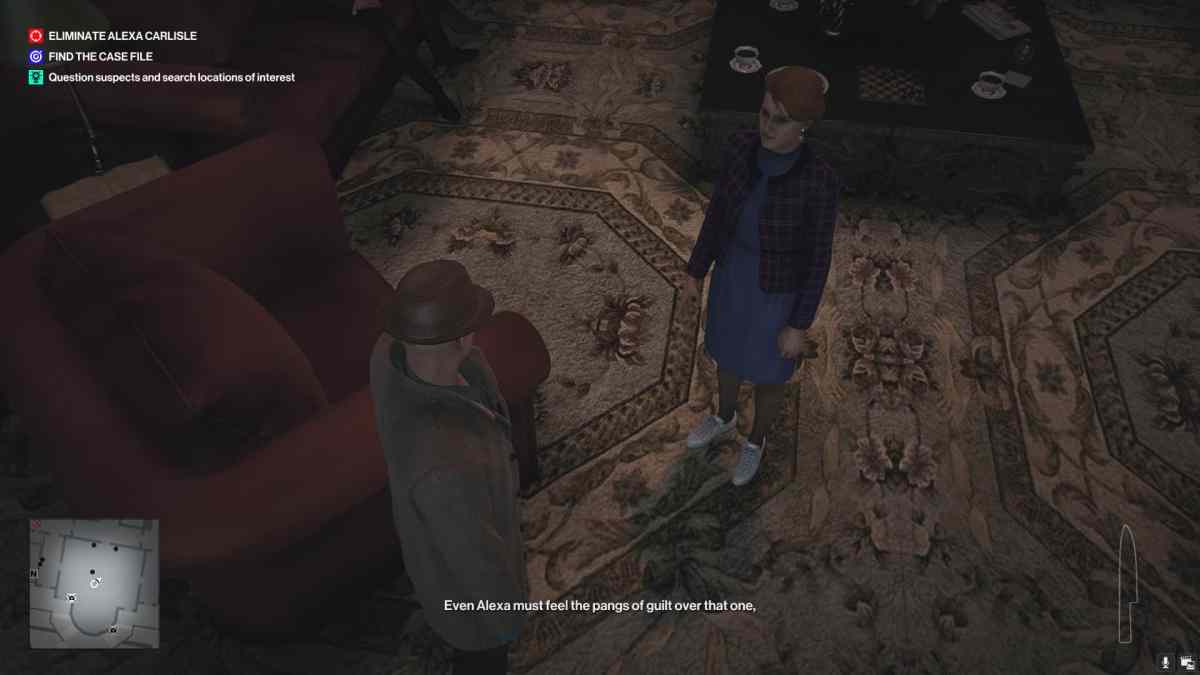The recent Hitman games have a lot going for them. They’re oozing creativity, extremely welcoming to newcomers, provide tools for some really great immersive storytelling, and have helped IO Interactive grow to the point where it’s now working on a James Bond game. But the levels themselves are the standout element of the World of Assassination trilogy, particularly how they’re remarkably dense and well designed. In terms of highlights, Hitman 1 has the beautiful Amalfi Coast of Sapienza. Hitman 2 has the jam-packed Miami raceway. And as great as the sweaty Berlin rave and posh Mendoza winery are, the standout level in Hitman 3 has to be the murder mystery set at the Dartmoor estate. Its surface-level inspiration from the film Knives Out and by virtue the adventures of Agatha Christie’s Hercule Poirot is clear, but the level succeeds as so much more than simple homage.
The introduction of the private investigator right from the start of the mission is such a smart way to immerse the player in this level’s tone, which is in stark contrast to the futuristic grandeur of Dubai. Tailing the PI through the overgrown shrubbery, crumbling walls, and babbling brooks of the Dartmoor grounds gives the house a feeling of opulence that’s pulled out of time as the world around it slowly falls apart.
Unlike Hercule Poirot and Benoit Blanc, this private investigator is quickly and easily subdued and stuffed into a conveniently placed wardrobe in an empty hallway. Once Agent 47 has assumed his identity, the true story of this Hitman 3 scenario is revealed — Madame Alexa Carlisle has faked her death and is planning to hold a fake funeral to boot. But her younger brother Zachary was found dead the morning of her funeral, with a sketchy suicide note in hand.

The heavily guarded Madame Carlisle is ultimately our assassination target, and there are a multitude of ways to get to her. But the central and most entertaining way is to fully immerse yourself in the role of the detective, pull out your proverbial magnifying glass, and scour the grounds for clues. This includes investigating the crime scene, speaking with each awful family member, and finding a way into every locked door of the manor.
By the time I started piecing together Dartmoor’s mystery, not only did I forget what my actual mission was — I genuinely forgot I was playing a Hitman game. I became utterly invested in unearthing this family’s secrets and solving the crime. The discovery of hidden doors, secret passages, and one-way mirrors made it feel like I was inside a game of Clue, which was only strengthened given the number of wrenches, knives, and guns scattered about the premises. The fact that I could literally accuse the butler of the murder made it all the more immersive.
But like all good Hitman levels, this is only one possible story thread to pull at. If you take a stroll through the hedge maze and into the garden, you’ll find the spot where the faux-funeral is going to be held. After a quick clothing swap with the undertaker, you can lead Madame Carlisle on a tour of her own ceremony, including the convenient moment to knock her into the open grave and shovel dirt on top of her. Or there’s the family photo planted in front of the opulent fountain on the side of the mansion. Disguise yourself as the photographer, fiddle around a bit with some wiring near the fountain, and Alexa will find herself at the receiving end of a jolt. These various arteries allow each run through the level to feel wholly unique.

On top of this, there are small stories scattered throughout Dartmoor that are ultimately unnecessary to the core mission but add so much texture to the world. Landscapers complain about their smug bosses, the kitchen staff consoles a heartbroken coworker, and the security guards talk about mundane relationship woes in a very nonchalant way that feels incredibly realistic. Every time I run through the level, I discover something new and gain fresh insight and appreciation for what IO Interactive has created.
Like a lot of the best Hitman levels, Dartmoor and its mystery feel like immersive theater. It’s a stage where you’re actively participating in the drama that unfolds. The same actors show up at every performance, and accumulating a more intimate knowledge of how the story plays out allows you to further impact its outcome. In that way, it reminds me of the incredible Sleep No More, a New York City-centric production of Macbeth in which the audience is allowed to roam a massive warehouse while the play is happening in real time around them. The way you simply exist in the world for a few hours shares a lot of video game DNA in the same way Hitman’s best stages have a theatrical quality to them.
Hitman 3’s Dartmoor is a standout level in a series known for standout levels. The treacherous web of the Carlisle family, the textured intrigue of their staff, and the atmosphere of the grounds all combine for an experience that made me momentarily forget exactly which game I was actually playing. I know it’s early on in the year, but Dartmoor is already an early contender for my favorite video game level of 2021.
